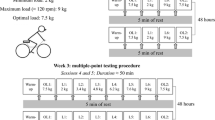Abstract
An isokinetic cycle ergometer has been developed to measure power output generated over a wide range of constant velocities. The ergometer system has two operating modes and it can be instantly switched from one to another. In its conventional mode the cycle ergometer is connected to a conventional electrically braked cycle ergometer so that the subjects can perform submaximal steady-state exercise. For maximal power measurements the system can be instantly switched to an isokinetic control mechanism which allows a constant pedalling rate to be set in the range of 23–180 rev·min−1. In both operating modes the forces generated on the pedals are monitored by strain gauges mounted inside the pedals. This enables information to be obtained regarding the direction of forces generated at the foot-pedal interface. The output from the strain-gauges was A-D converted and stored along with data giving pedal and crank position. Data was sampled 150 times in each revolution of the crank. Force data are usually analysed for maximal peak power (highest instantaneous power generated during each revolution), mean power (power generated over a complete revolution), extension and flexion power (power generated during leg extension and leg flexion respectively). This system allows characterisation of the relationship between maximal leg power and pedalling rate, both under control and exercise-induced potentiation and fatigue conditions. Thus it is possible for example to quantify instantly the magnitude of fatigue induced by preceding dynamic exercise of a given duration, intensity or contraction velocity.
Similar content being viewed by others
References
Bar-Or O, Dotan R, Inbar O, Rothstein A, Karlsson J, Tesch P (1978) Anaerobic capacity and fibre type distribution in man. Int J Sports Med 1:82–85
Evans JA, Quinny HA (1981) Determination of resistance settings for anaerobic power testing. Can J Appl Sports Sci 6:53–56
Lakomy HKA (1986) Measurement of work and power output using friction-loaded cycle ergometers. Ergonomics 29:509–517
Lanooy C, Bonjer FH (1956) A hyperbolic ergometer for cycling and cranking. J Appl Physiol 9:499–500
Sargeant AJ, Hoinville E, Young A (1981) Maximum leg force and power output of human muscle in maximal cycling exercise. J Appl Physiol 51:1175–1182
Thorstensson A (1976) Muscle strength, fibre types and enzyme activities in man. Acta Physiol Scand [Suppl] 443:1–45
Williams JH, Barnes WS, Signorile JF (1988) A constant-load ergometer for measuring peak power output and fatigue. J Appl Physiol 65:2343–2348
Author information
Authors and Affiliations
Rights and permissions
About this article
Cite this article
Beelen, A., Sargeant, A.J. & Wijkhuizen, F. Measurement of directional force and power during human submaximal and maximal isokinetic exercise. Europ. J. Appl. Physiol. 68, 177–181 (1994). https://doi.org/10.1007/BF00244032
Accepted:
Issue Date:
DOI: https://doi.org/10.1007/BF00244032




